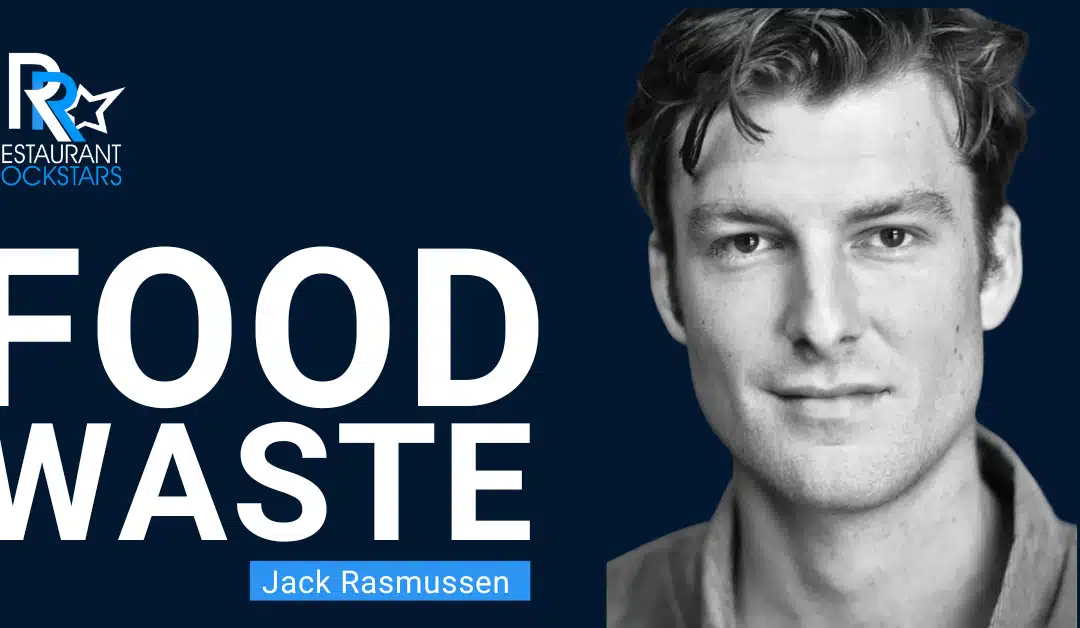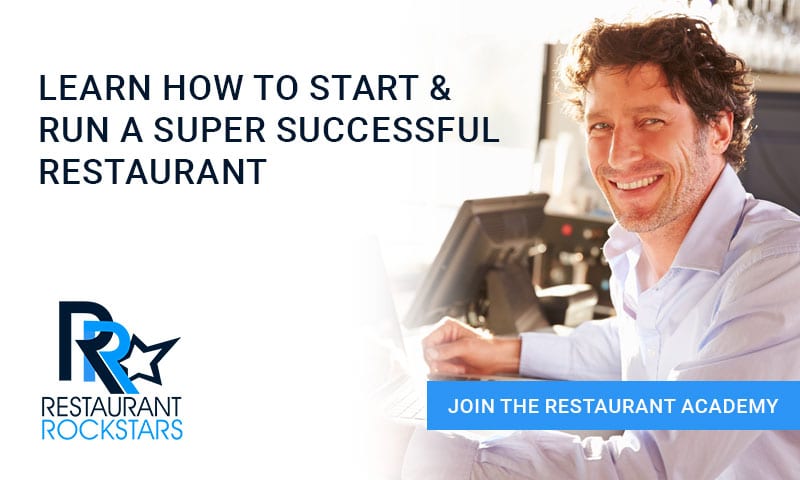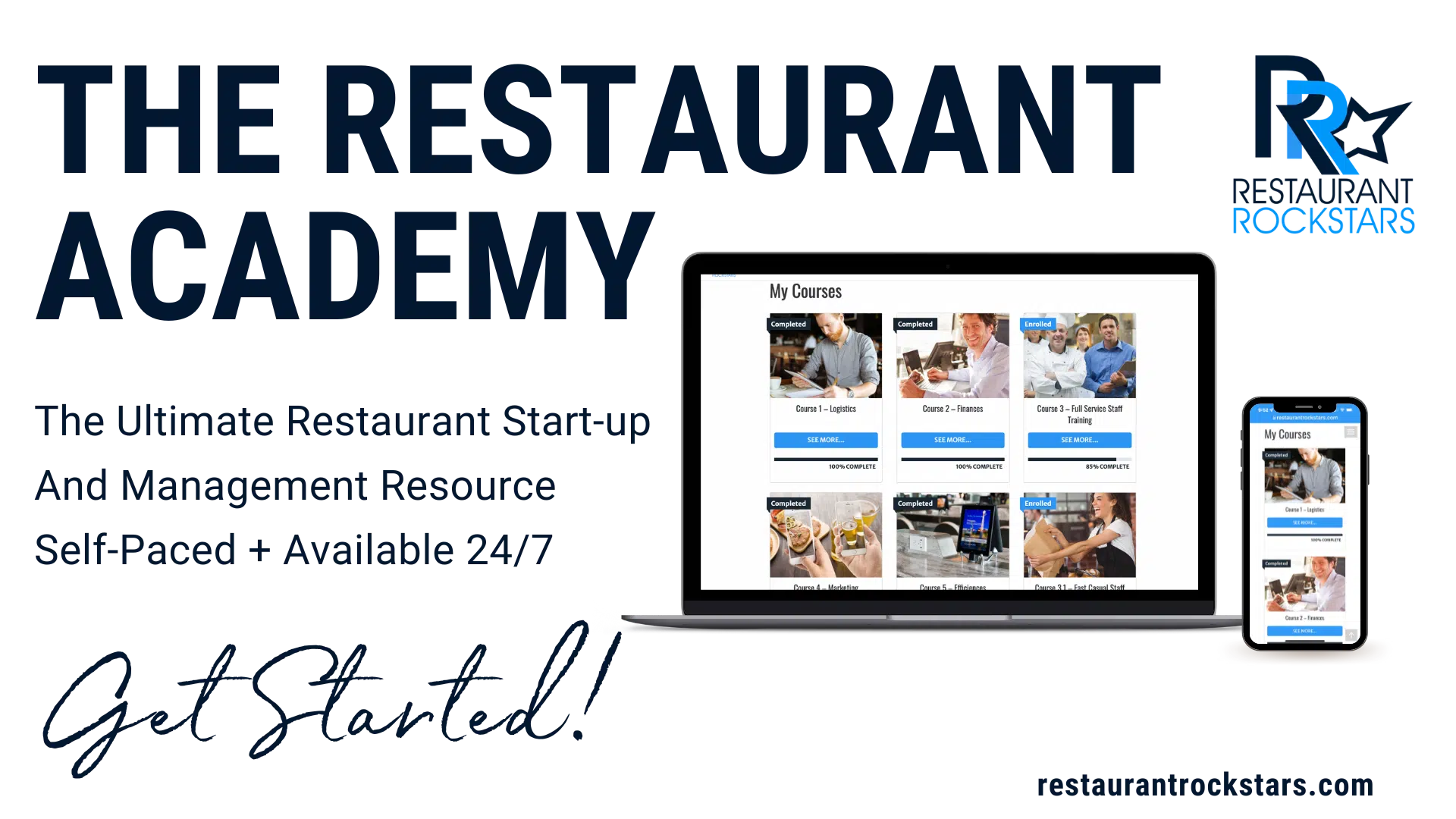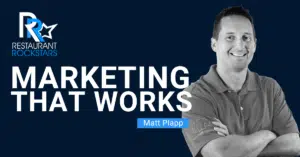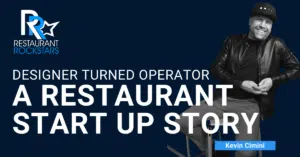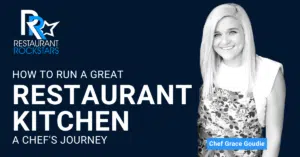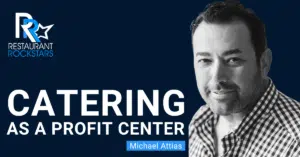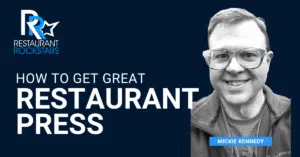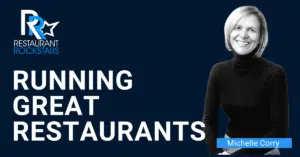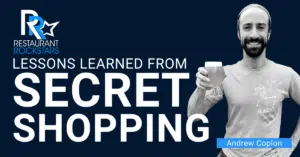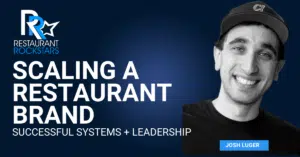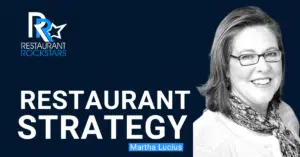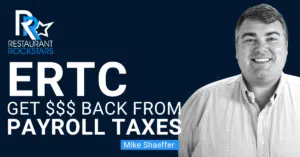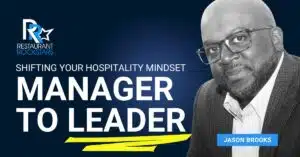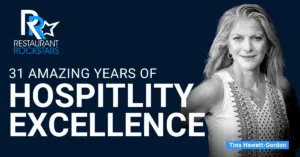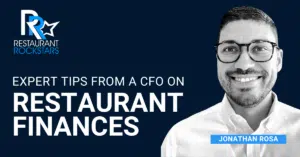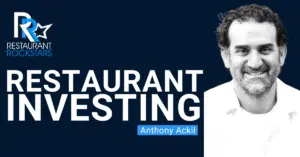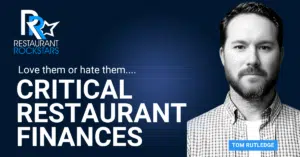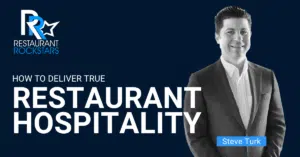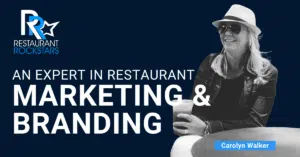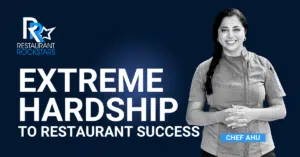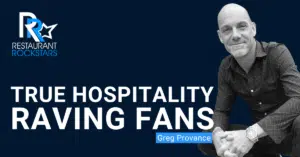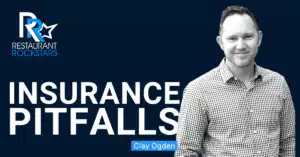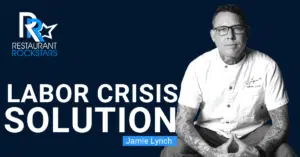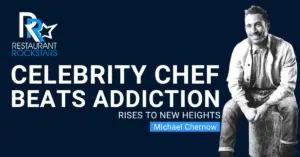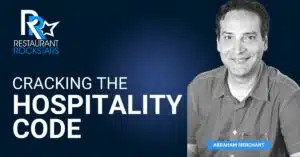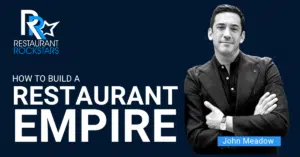Restaurant Rockstars Episode 316
How to Feel Good About Food Waste
LISTEN HERE OR ON YOUR FAVORITE PODCAST PLAYER
Prefer to watch the interview?
Click the video below.
For all the love we put into our business and the joy we provide our guests, unfortunately, one of the downsides is food waste.
This bothered me when I owned restaurants, and with the widespread hunger in our country, it still does.
Imagine if every restaurant, yours included could be part of the solution and not the problem!
In this episode of the Restaurant Rockstars Podcast, I’m speaking with Jack Rasmussen an inspired guy with a solution to the restaurant food waste crisis.
Besides being a business scholar, entrepreneur and author, Jack Rasmussen has made it a mission to feed the homeless. Restaurants are at the very heart of the answer.
Listen as Jack tells us:
- How he co-founded “Good Samaritans”, a Los Angeles non-profit that feeds the homeless
- His brainchild for “FoodMate” which collects un-used food from restaurants and distributes via food truck to people in need on the streets
- How your operation can minimize food waste by working with local foodbanks and get tax credit for donations
- Board of Health regulations concerning food waste and donations
And we talk about Jack’s new book “Fine Dining, The Secrets Behind the Restaurant Industry”, his distance learning platform “Screen 360TV” that raises cultural awareness for kids, teaching English in Taiwan and MORE!
This guy does it all!
Watch or Listen to this episode, go out there and Rock YOUR Restaurant and TAKE ACTION!
Roger
Connect with our guest
Instagram: @razz5
LinkedIn: @razz5
TikTok: @thejackrazz
Facebook: @razz5fb
Website: jackrazz.com
0:00
What inspired me to create a nonprofit with my best friend during COVID, where we partnered with food banks, and basically just went out ourselves and fed fed the homeless people because we wanted to just be the feet on the ground actually handing them food to try to make direct change during the pandemic.
0:26
Hey, thanks for joining me again, on the podcast. I think about food waste all the time. I really have a problem with waste of any kind. But restaurants are huge generators of food waste, as you know. And it’s not something that you’d ordinarily think of in the day to day challenges of running your business. Well, this week’s episode talks about a really noble program, a dynamic young entrepreneur is feeding the homeless, from waste from restaurants. And it’s a huge idea. It’s a huge program. It’s a beautiful thing for the future. So please take a listen to this episode. And we can all make a difference. Don’t miss it.
1:05
You’re tuned in to the restaurant rockstars podcast, powerful ideas to rock your restaurant. Here’s your host, Roger Beaudoin.
1:20
Listen, I’m all about marketing. But believe me, very few marketing ideas today are fully trackable. Where you know exactly where the business is coming from AD, you also know that it’s generating a positive return on your investment. Now, I no longer own restaurants. But if I did, this idea would be at the very top of my marketing plan. It’s all about birthdays. Everyone has a birthday and they are a huge Let me repeat that huge source of business in your restaurant. Why wouldn’t you want to focus in on reaching everyone with a birthday in your area? Well, you can with the birthday club from fan Connect. Best part is they do everything for you. You get a turnkey marketing system that sends birthday cards in advance, inviting people to celebrate your restaurant from your area code, plus a signup strategy for your existing customers. New business, repeat business hire check averages and a massive customer database. You can get all this with the birthday club. Check it out and sign up now at getfanconnect.com/birthdayRockstar.
2:30
Listen, this is important. If you haven’t heard of the employer retention credit, your business can receive lots of money back from the IRS money you’ve already paid in payroll taxes. Now the ERC program as it’s known is available if your operation had fewer than 500 employees, you had to shut down or partially suspend your business or you had at least a 20% reduction in business due to COVID 19 in any quarter of 2020 and the first three quarters of 2021. Now how much is the credit up to $7,000 back per employee per quarter for 2021 and up to $5,000 per employee in 2020. Listen if you have 10 employees today and meet the requirements you could receive up to $260,000 back in a refundable tax credit. Now the faster you apply, the faster you get the cash, think of it as found money that you can use for any purpose payroll cost of goods, business improvement or other business expenses. Again, best of all, you do not need to pay this money back now works as a company that will do all the heavy lifting for you and get your business back the money that’s due. I’m speaking from experience here with works I received a sizable amount back in all available quarters from my former restaurant and I couldn’t be more pleased with their service their people and their process for a no obligation konsult Click the link for whirks in the show notes to this episode. Don’t miss out. Get your consult today.
4:00
Hey there. Welcome back to the podcast and another exciting guest Mr. Jack Rasmussen. He is an author, entrepreneur and a food waste activist based in Los Angeles, but I believe I’m speaking to him from Taipei, Taiwan. Welcome to the show. Jack, how are you?
4:17
Thank you, Roger. Thanks for having me. I’m excited to be here. Today.
4:22
Well, you have a very noble mission that is sort of near and dear to my heart and I think it’s something that every restaurateur owner, operator, GM, anyone in the hospitality industry can have a huge impact on and we just need to raise awareness for it. So I’m really glad to be here but before we dive into all of that, I’d love to know you know, what are your you You seem like a very passionate guy you know, a lot of things must really light you up. But what what do you do in your spare time or what what really inspires you? What do you love to do?
4:53
Yeah, that’s a great question. I think ever since I was young, I mean, I’m only 21 years old. So I, I have had a very short life so far. But I think in my 21 years, what really inspires me is motivating people and inspiring people through storytelling. It’s always been something that I have loved doing. So that’s sort of why I really wanted to write a book about something. And I’ve always loved food and the restaurant industry. So that’s sort of what I focused on for my first book. And so yeah, that’s, that’s really what inspires me is I love impacting people. And that’s why I’m here in Taiwan, is I’m actually teaching English as part of a Fulbright scholarship. So I get to teach, I’m teaching at a local, junior high school, secondary school here. And I get to teach Taiwanese students English through storytelling, so I get to play games with them. But basically, yeah, I love impacting people through storytelling. And that’s why I sort of went to the University of Southern California, so I could pursue a career in entertainment. And that’s also why I wrote a book.
6:24
Fantastic. How long will you be in Taiwan?
6:28
I’m gonna be here until August of next year, I believe.
6:33
So another year from now, that’s fantastic. Yeah, you’ve got a whole life ahead of you. And I can only imagine the impact you’re going to make on this world. And we’re going to cover a lot of that right now. But again, tremendous. And right now, obviously, how fulfilling and gratifying it is to work with young people and teaching them English. And it just sounds like you’re having so much fun. And they inspire you in many ways, and you learn from different culture. And you’ve got another cultural mission we’re going to talk about in a little bit about, obviously, the the TV thing, but right on, let’s talk about other backstories. Have you ever worked in a restaurant in your very young 21 years?
7:14
Yeah, well, the closest thing I’ve gotten is I worked at my local grocery store. So I’m from a small town called Los Gatos, California, in Northern California, about an hour south of San Francisco. And when I was younger, in high school, I got a job at the local grocery store. And this is sort of where my, just my love for trying to stop food waste I started because I would see all the food this grocery store would throw out. And they would make me it would make me so angry three people right on the street, why don’t you just walk over and give it to them? Or why don’t they donate it to local food bags? You know, why don’t they give it to people who could, you know, create different recipes, I just thought there were so many different things that they could do. So that’s sort of where my love for trying to end food waste started, was seeing all the food waste at the grocery stores. And then that pushed me to do more research. And then I realized it’s such a big problem in the United States as we waste about 40% of our food, which is so alarming to me.
8:36
That a huge percentage. That is absolutely crazy.
8:39
Yeah, and I don’t think I don’t think people really realize it. And so I wanted to do anything I could to try to help end it. And then that’s what inspired me to create a nonprofit with my best friend during COVID, where we partnered with food banks, and basically just went out ourselves and fed fed the homeless people because we wanted to just be the feet on the ground actually handing them food to try to make direct change during the pandemic.
9:19
How was that received? I’ve been to that area of LA. I lived in Los Angeles for three years. And we used to obviously work downtown and we came across this problem quite often. And my partner and I here and there would would buy food or you know, hand something out to people and sometimes it was well received. And sometimes it was those people that were just heavily influenced with drugs and alcohol, and it’s like they were just, we couldn’t help them. But in general, I mean, how do you find the people that are most receptive to this or how did you can you explain a little bit more about your experiences there? Because I think there’s some there’s definitely some depth to it.
10:00
Oh, yeah, 100%. For us, when we started out right away, there was definitely a lot of dangerous situations where we, and we would have high schoolers help us. And a lot of them were were very young, because we, we kind of started a volunteer program where we would get high school students to come and we’d sign off their volunteer hours. So we just had to make sure that they were aware that some people, obviously, were not in a regular state of mind, you know, people were gonna be on drugs, or some people, you know, wouldn’t know how to respond to them. If they asked them Do you want a free lunch, they would just, you know, yell at them. So I think it was just being clear with our group, and setting a foundation before, you know, going out into, you know, the public with these people that we didn’t know a lot of the times. But I think also we really strive to create relationships with people because her I love that we would go, we would go out to the same spots. So after a while we created relationships with, so they knew who we were, like when they would see my face to be like, Oh, that’s Jack, he’s giving me food. And so then it would become a conversation, where do they care? How are you have you been? And so we It will be fun, because every week, we look forward to checking in with them. And it became more like a relationship thing, rather than just a transaction, you know, and I think that’s what made it special.
11:49
That is very gratifying and very, very fulfilling. I mean, that just warms you up from the inside building those types of relationships, knowing that you’re making a difference in someone’s life, and that they really appreciate what you’re doing. And it becomes a bond of friendship, all those things. That’s, that’s tremendous. Let’s, I want to make a differentiation between your nonprofit Good Samaritans and food made two very dynamic IPs that are both making an impact which one came first? And if you could kind of walk us through both and you know, and the end result and impact either of those, or both of those who are making.
12:25
Yeah, so good Samaritans of Silicon Valley. We I started that in 2020, right when the pandemic hit, we started that when I came home from USC. I wanted to do something. And so me and my friend created that and basically got a group together in our hometowns and started partnering with different food banks. And originally it started where, where we would just make sandwiches, so I made a peanut butter jelly sandwich, and then put some fruit and a banana and a lunch bag. And we made we started out making 20 a weekend and we’d go out every weekend, and just feed 20 people to make sure they had lunch with extra food. And then gradually built over time to 100 lunches a weekend. And the team grew. So it originally started with four people. And then it grew to almost 15 People weekend. And now obviously me and my friend who started it were off doing our own thing. So now we have high schoolers running it every weekend for us. So we it continues to go and it’s an active nonprofit in the Bay Area in California. And then we also did a few service days in Southern California. And food may is another idea where I had a class, I emphasized an entrepreneurship at USC through my bachelor’s in business. And I had a wonderful class with Rob Shogun. That was basically venture management. And so I always had this idea called Food mate. And I had a group around me and it was my idea to basically kind of inspired by my experience at a grocery store but pick up extra food at different grocery stores and restaurants and then collect it at a local food truck and then make make recipes at low prices and kind of play replace the food truck in low income neighborhoods. So then that food that would usually go to waste would be recycled. And then hopefully given to hungry people in these low income neighborhoods. So that was the idea behind that. And we pitched it a few times. And I really wanted to pursue it more, because it did get some traction in the class. But then I just got I got so busy. I didn’t get to pursue it further.
15:24
You’re talking about a real interesting logistical challenge. Okay, because right now we’re talking about collecting food from restaurants and grocery stores, now grocery stores, and restaurants, let’s talk about the perishability, and the separation and the collection process, and the safety issues that go along with that, because that seems to me to be the biggest challenge to make sure that everything that you serve is safe. And you know, and then there’s this whole board of health thing we’re gonna we need to get into, but talk to me first about the logistical process or challenges associated with what you do, and how you get it to the people and make sure that it’s safe.
16:10
Yeah, and that’s, that’s one of the main things and why it’s very hard. Because when I did actually talk to restaurants, the hard thing is, is it all has to be approved by the National Food Association, and has to check all the boxes. And a lot of the times restaurants are too busy to really think about that stuff. So it was very hard. It’s very hard for food may, if it were to happen, and even my teacher, professors joven said this, that I would either have to choose grocery stores or restaurants and working with restaurants trying to pick up their food and then re serve it is just kind of unsafe, because how do you know if it’s safe to eat and consume? Yes. Whereas grocery stores at all the food has an expiration date. So you can kind of make sure that you know what you’re serving is not past the expiration date, or it’s right on the expiration date. Per perfect. So that was the hard thing. Yeah.
17:29
Unbelievable. Let’s talk about besides those logistics, there are certain expenses involved in doing what you’re doing. Are you accepting donations? Do you have a crowdfunding source? I mean, just driving a food truck around in California with like $7, gas prices and all that kind of stuff. I mean, that’s just one expense. And there are more. Obviously, you have volunteer. I’m hearing high school kids. And it’s awesome that people have gotten on board on this mission. But there are still expenses, how are those covered?
17:59
Yeah, we have donations. So all the food banks in the Bay Area, donate their food to us for free. So we work with Habitat for Humanity. Milpitas Food Bank, South fish food bank, we’ve worked with the History Club of Los Gatos. And then we also have a lot of families, local families that will donate their food that you know, sometimes we’ll have loaves of bread, we’ve also expanded to hygiene products and clothes. So people will donate their extra clothes that they don’t want or give a bunch of hand sanitizer, water. So we’ve done all that as well, which is been super helpful.
18:53
Now, interestingly, you’re talking about food banks donating food to your cause and your mission. Am I understanding correctly that food, certain food banks are taking in more product than they can distribute to the people that come to them? So this is just another channel for them to distribute an overage of food that they have to make sure that that doesn’t go to waste? Because a lot of it is shelf stable, of course, obviously packaged products, but is Am I correct in assuming that they have an overage in some cases, and you’re just another outlet to obviously distribute it to the right people?
19:29
That’s exactly right. Yeah, it’s, believe it or not, even food banks don’t have enough people to give the food to sometimes and we just want it to be another helping hand to get it to people who really need it. Because I will see struggling people on the street, you know, and I think it’s just easier to be kind of that in between to bring the food to them. Because a lot of a lot of people don’t even have the, you know, they don’t have the knowledge to even go to the food bank. And so they’re left on the street to starve, you know? So yeah, you’re right.
20:14
Wow. Now this is a universal problem. And this is one giant idea that you have, but could be exponentially expanded. But our audience, of course, is restaurateurs and franchise operators and general managers. And there is a tremendous amount of food waste in these restaurants. How do we raise awareness for this problem? How do we get people to understand that it is a pride and passion and noble part of what we do, to not let all this food go to waste and to help those that are in need, because there’s this business that is good to the operators. It’s it’s their livelihood, it’s providing them with their futures. But then there’s so many people that can’t afford to go to those restaurants, but are hungry, and, you know, can’t afford to go to any restaurant really. So how, you know, you obviously have lots and lots of ideas. And this is one platform to get that message across, what would you say to operators to just think twice about this problem, and just start today or tomorrow, in one small way. And then as momentum builds, and as it becomes, you know, viable for them? How do you create a program? Do you have any advice to operators about what you would tell them to start today or tomorrow?
21:38
Yeah, well, I would just tell them the facts that we waste 40% of our food. And I think every operator restaurant tour, has to understand those numbers. And they also have to understand the amount of people who are dying of hunger every day. And a lot of those people are children who haven’t had the chance to live most of their lives. So I think once they realize, you know, the problems, the real world problems in our society, that means so much more than, you know, making the best meal that you can make, you know, at a Michelin star restaurant, what really matters is just feeding people who who need to be fed. And I would tell restaurant tours to understand that first of all, and I think that alone should inspire them to take a few more steps. Instead of throwing out you know, all their produce, you know, that one night are throwing out the steaks are throwing out all this food kind of second, second guess that and maybe think about where they could be donating that food, or, you know, maybe reusing it in some form, and another dish or just recycling it somehow maybe partnering with a local food bank, I think every restaurant should definitely partner with a nonprofit, whether it is a food bank, or a homeless shelter, or some sort of place where they can donate their food right away at the end of the night. Because I don’t, I just don’t think throwing out food makes any sense. In today’s world, as we continue to just have so many people on this planet now. We’re it’s so overpopulated. So I just think it makes no sense to throw out food and I think we should just be more conscious of that every meal we have just think about, are we eating it? Are we just throwing out half of our meals, you know, and I think owners and operators to think consciously about, okay, this is all my food source? Am I using all of it? You know, what, where can I be? Where can I be using it? You know,
24:08
a lot of restaurants have have made a huge headway in recycling, and okay, tin cans and bottles and all that kind of stuff. And yes, obviously the planet and the environment is also a noble mission. But it’s like they’re putting so much energy and effort into recycling. It’s like this seems like a more important priority to also implement as long as you’re going to put the energy into that. It’s like this will make a real difference in people’s lives like immediately. And like you said, there are people starving people dying from this every day. I think, I think I mentioned earlier before we got on the recording about a recent podcast. Yes, that’s obviously feeding people because their mission they recognize that I think 25 million children around the world die every year of starvation. And it’s like when you hear these kinds of statistics and The 40% of food that gets wasted, it just makes you say, wow, you know, I can make a difference, I can make one small effort today, that will lead to a bigger, you know, your noble mission on a grand scale, and everyone can make that difference. So I really appreciate, you know, that advice. And pretty much no matter where you are, there are homeless shelters and food banks. And it’s not necessarily in the largest cities, which clearly there are, but smaller ones as well. And then even at the local church level, you know, there are donations for food pantries and churches, that is another option that also help facilitate this. So that’s, that’s just something that I want everyone to hear. So I’m glad you’re here sharing that with us. Let’s talk about restaurant customers that perhaps take food away that they’re not going to eat. It’s like, okay, everyone gets they used to call it the doggie bag when I was growing up. And now it’s the takeout container, that sort of thing. Is there an impact that guests can make with their leftovers versus taking it home put in their frigerator and eating it? Is there a safe way of distributing those leftovers? Because some of it is a whole half a sandwich or something else? Dessert? Maybe? I mean, who knows that something?
26:18
Yeah, that’s a great question. That’s actually what inspired me a lot, to kind of talk about food waste through my book is I would go out to different restaurants. And nothing would make me more angry than looking over to tables next to me and seeing customers leave and their full plate would just be there is like untouched uneaten. And then seeing that aggressive thrown out. Just it makes me so mad. So yeah, I’ve always been a huge advocate of leftovers, just for that reason, because I don’t like wasting food at restaurants, especially at very high quality restaurants like Michelin star restaurants, where so much is put into every single plate, it just makes no sense to me why you would go to a restaurant and not eat the food. Right. And I think, I think in today’s culture, we see it a lot where business people, or people kind of just going for the social aspect will sit at a restaurant and talk and won’t even touch their food. So the food is so secondary to them. They’re not, you know, going back to being conscious of that. It’s not even on their minds, you know, it’s it’s just there. And so they’ll, they won’t think about it. And I think that’s why a lot of food does go to waste is these people are going to restaurants just to sort of use it as a meeting spot. And they’re not actually thinking about the food, which is what, what we need to think about. So what I say is, is respect your food that’s sort of my tagline is just think about it. You know, whenever you go to a restaurant, you know, you’re there to enjoy the food, obviously, you know, you want to enjoy your company and get something done if you’re doing a meeting. But I just think respecting your food is a great way to look at it where every meal you have, you should just you know respect that food. And remember, you know, those statistics that we keep referencing?
28:48
Yeah, I mean, that’s absolutely true. And in the business meeting thing, I’ve been in business meetings like that, and it’s almost uncomfortable when you’re invited to lunch, maybe it’s a job interview, maybe it’s something and yes, you order food, but the conversation prevents you from eating the food. And then next thing you know, it’s like, okay, what do we do with this, we’ll take it, you know, we’ll take it home and maybe get eaten. Maybe it’s not an even bigger problem. I mean, I was in the restaurant industry for 20 years, you know, founding four or five different concepts. And parents will order food for their kids that goes uneaten. And the kids off playing the video games, and they might take one bite of that burger and the whole full plate of fries, or whatever it is, and so much food gets wasted by kids that just for whatever reason, the family goes out to eat and the kids just don’t eat the food, you know, and I saw that forever. And that’s another huge problem.
29:39
Oh, yeah. 100%.
29:42
Let’s talk about the safety issues again, because different states have different rules. And obviously there are federal laws in place, but every state has a board of health and, you know, restaurants get inspected and all that and it’s such a stringent process of refrigeration, and things that you do to pool hot items and you know that whole thing. But now we’re talking about, obviously food that’s already been prepared that’s been sitting for a while. And certain foods obviously tend to, you know, accumulate bacteria faster than others, all this kind of stuff. It’s like that is a very big challenge. How do we address? Or is it is it getting those parameters from your state, and the Board of Health on what is allowed what isn’t allowed, what are best practices and how to deal with prepared foods so that no one does get sick, because, obviously, we want to avoid that.
30:36
Guys, I’ve always believed in systems to run a really effective restaurant, they say you have a system, if you can walk away and leave your place for a day, a week or a month. And it’s just as successful, just as profitable when you return, if not more. So. Now, the staff are really the foundation of this. And it all comes down to the word empowerment, you know, if you’ve got really great people, and if you can develop those people that have your back, and to run it as if they owned it, treat everything as if they had to pay for it. That’s a super powerful system. Once you have the staff in place, it really comes down to three things. It comes down to one staff training, development, recognition and rewards to create what I call your dream team, how to empower your team to think and act like owners and to treat everything as if they owned it, and had to pay for it, and to deliver amazing guest service experiences to your customers to serve and sell because sales are the lifeblood of your business, not allowing order takers on the floor. But teaching everyone to recognize opportunities and make suggestions that we know that customers will enjoy and appreciate. It all comes down to training, training, training, number two cost controls and maximizing profit, you need to know your critical financial numbers on a weekly basis. And it only takes 10 minutes. But you need to understand these things. How about your daily breakeven how much it costs you to open the doors to your restaurant each day. Inventory is not just walking around and figuring out what your order is that week, it’s knowing the true value of your goods on hand at any given point in time. And you need this information to be able to calculate your true food and beverage costs. Your labor costs are also important and running a weekly labor analysis against sales. If you know these things, I can teach you how to maximize your profit and control your costs. And then number three is what I call marketing firepower and affinity. You know, affinity is defined as a really powerful sense of loyalty and belonging where your customers become raving fans. And they’re like an army of brand ambassadors spreading the word for your restaurant. Well, all of this is included in the restaurant rockstars Academy, if you really want to take your restaurant to the next level, post pandemic, things are heating up, customers are coming back. Now’s the time to really maximize your opportunities, maximize your sales and profits and create that dream team staff. Check it out at restaurant rockstars.com. It’s the restaurant rockstars Academy!
33:12
That is a great question. And I think I think more meetings with the Board of Health should be had in every state because I do think there should be a way where where we could try to recycle food on people’s tables when it’s untouched. I mean, because I’ve seen a lot of food just completely untouched. And I know it’s hard to measure that. And to see, you know, because technically, you’re really not supposed to serve food that you’ve placed on someone’s table. Right? That’s not it’s not really loud. So I don’t know, we we definitely could reevaluate that, and maybe just examine how people are eating at every single table and see if they’re actually touching the food and kind of putting back material on the food as you said, because if not, if it’s not being touched, if it’s not being contaminated, you know, there’s no reason why that can’t just be served to another another person you know, or, or given to someone else for their agenda that night, you know, a staff member or something. So I just think more conversations should be had with with boards and every state to sort of rethink that idea of leftovers and how can we reserve things that haven’t really been touched? Which is which is interesting for sure.
34:46
Waste and spoilage in restaurants increases in restaurants, food costs, and food and labor are the two biggest costs in restaurants. And obviously the whole idea behind running in an enterprise of any type is to make a profit clearly You know, we do it for love. But we also do it for profit. And obviously, when you’ve got a waste and a spoilage problem in the restaurant, then your food costs go up. And that means your bottom line profits go down. So if we donate food there is in Well, I would suggest that anyone listening, obviously consult their CPA, but they can have a tax deduction for any of the food that they donate to a shelter. And there is a financial benefit to a restaurant to do this, that helps both the people who are the end recipients of the food, but also, obviously, that can obviously help your bottom line if you’re getting a tax credit when you’re doing your taxes as an expense line item on your profit and loss statement. So I just wanted to get that across as well. Because the whole goal behind the show, obviously, is to bring the problem in the awareness to light with my audience, and then just tell them, This is what you can do. And also, by the way, pick up the phone ask your your tax accountant, you know, what can I do if I were to only donate food that’s going to go back to a shelter to a homeless place or a food bank or whatnot, because there is a benefit there. So that’s great, too. All right, let’s let’s talk about the book. You wrote a book. It’s called fine dining. And that secrets behind the restaurant industry? Do you have a copy of it close by the you can hold up any chance?
36:24
Yeah, I do. Let me let me Yeah.
36:27
Would you do that? I’d love to show the book because I’m gonna find out ask the area. Okay, so fine dining. That’s very cool secrets beyond the restaurant industry. You started off this podcast by telling us that that was obviously a motivating goal in your life. You’re a storyteller. You want to tell stories? What’s, you know, what’s the, you know, the whole in and out of the book? And how did that first How did the idea for this book come to be and then tell us what it’s about?
36:57
Yeah, I met Eric Koester, who’s an entrepreneurship professor at Georgetown College in Washington, DC. And I called him, I really wanted to create a book. And because I love writing, and he has this amazing program called the creators Institute. And I had a long discussion with him last April of 2021, last year, and we were talking just about my passions, and how I love to sort of, obviously storytelling, but sort of more focused, I really love food and film. And I wanted to write something about food. And then I kind of focused in on restaurants. So I started doing a lot of research, where did the first restaurant open, which is in Europe, and then slowly, it spread to Asia while I’m now in the US sort of at the same time. And then in the US, you know, came over to California. And that’s where we saw the farm to table movement, Alice Waters, Jeremiah tower, Wolfgang Puck, sort of the trailblazers of that movement, and all of these restaurants, sort of partnering with local farmers and making, you know, fresh, very fresh dishes and having very seasonal menus, where they would switch up the menu for the seasons. And that sort of started in California, where I’m from, and now it’s all over the United States where all these people love this farm to table idea where they have fresh ingredients. So I did basically did a lot of research. And then I started interviewing chefs. And it sort of just snowballed. I didn’t know when I would finish it, but I finished it in November of last year. And then it went on presale. And then I met a lot of different chefs. And now there’s a foreword in the book by actually a Celebrity Chef Michael Mina, and then my dean at USC, Varun Soni, and then an entrepreneur David Blasco. And then Tara Brennan, who has a nonprofit where she actually feeds homeless veteran in Los Angeles, which is super cool. So, yeah, it was a really exciting process. And now it’s on Amazon. So yeah, it was it’s really fun.
39:42
How long did the whole writing process take from the initial inspiration then there was the research phase. And then there was putting it together as a narrative so that it, it flows well. And then you probably went through numerous edits with probably professional editors or people that were really? No, I mean, I can’t speak it sounds, you’re really talented guys. So I’m sure your writing style is very engaging. But still, the editing process is part of it right. And then there’s, you know, Penny is your publicist, and she reached out to me to make me aware of you, as a guest on this show. So you’re very young guy to have a publicist who have written a book to be to have done all the things that you’ve done. And now, okay, you got a book on Amazon, tell us about the process, because that is a very involved in depth, you know, journey.
40:32
Yeah, it was, it was really hard. I basically, was word vomiting on the page I had so much to write about. But for a book, you really need organization.
40:45
Yeah, organizing your thoughts and having it flow methodically, right?
40:48
Yeah, exactly. So it kind of just, when I, when I was writing, and I have this, this just full on script of just huge blocks of just words. And then that’s why I sort of had to divide it. So I realized, okay, this sort of, is like, history, present, future, and a really cool way. And, and I was kind of looking at it, like a movie sort of, and then I was thought, Okay, I could divide it into those three parts, and maybe create three different parts to my book. So it’s, that’s sort of how it’s divided. So part one is history, have a seat at my table. And then part two is let’s eat major keys to success. And then part three is the future shoots for the Milky Way. And basically, each part is a different, different section on how I sort of look at the restaurant industry. And so yeah, it goes history, which is very much research based. And then the middle part, keys to success is very much so interview based, where I give keys to success from restaurant tours, that I was lucky enough to meet and interview, and then ending shoot for the Milky Way is more of a very broad statement to entrepreneurs everywhere, of just encouraging them to take that leap of faith and pursue their passion project within entrepreneurship, and why it’s it’s so beneficial to sort of be independent, and have your own autonomy and kind of leaving your legacy on the planet because life is so short, you know, so might as well, awesome. take that leap, you know.
42:50
That’s fantastic. Thanks for sharing that story. You’re making another impact with something called Screen 360. TV, and that is a cultural platform. Tell us all about that. How did that come to be? What does it do? It impacts kids lives as well, which has some connection to what you’re doing now teaching English, but tell us about the screen. 360
43:12
Yeah, I love this platform so much. So I took a few entrepreneurship classes at Stanford University in 2020. And I met this wonderful lady named Katie Kavanaugh, who had been working on this program for 10 years, but it wasn’t really going anywhere. And I really wanted to help her because its mission, which you referenced is using international films to teach cultural literacy and students K through 12th grade. And I loved I loved the mission and vision because I love films. So when I met her, I was like, I will really want to help you and to try to pivot this pivot this business to something that could be you know, sold. And so I I helped her sort of pivot to focus on AP and IB classes, which is advanced placement and International Baccalaureate classes in the states and then obviously International. And we started a pilot program in my high school, Archbishop Mitty High School, which is a private Catholic High School, where we would go into periods and we’d show them an international film and, and, you know, get them talking and the whole discussion part is what’s really important to us. And then we would bring in the directors a lot of times so they could discuss with the directors, and we would mostly focus on language classes, English classes, and history classes. So we partner with those types of teachers and We did it in a few other schools, and we would connect schools and Poland or schools in India, with schools in the United States. So there could be a cultural exchange. So they would watch a film together and then discuss it, which is really cool. So they can meet students in different cultures and, and get that real in person cultural exchange. So that’s that screen 360. TV, and I’m still helping her a little bit. Even here, my hope is to connect some Taiwanese students to us students. So that’s something that’s one of my goals. While I’m here,
45:44
fantastic. I don’t know how you find the time to do all these different, you know, objectives and missions. It’s amazing, like you do oversleep.
45:56
I do sleep, but I just life offers so much, you know, so I want to soak it all up.
46:06
What’s next for Jack Rasmussen? What are your goals for the future beyond what you’re doing now? Or how do you see taking what you’re doing now to the next dimension? I mean, how do you see yourself or even strategically plan five years out? 10 years out, this is what I really want to accomplish in life. Obviously, you’ve got a strong business education behind you a lot of entrepreneurship we have we share that, you know, I have similar experiences as well, obviously, but Go on, tell us what’s next for you.
46:36
I want to get into the film industry more. So I have a talent agent now. And I’m working with a talent manager, both based in Hollywood, in Beverly Hills, and I really want to pursue acting. So I’ve done I’ve done a lot of classes at La Acting Studios. And I really, really like it and I it I find it very fulfilling as compared to finance. I worked for Wells Fargo last year, and I didn’t find that fulfilling. Yeah. So I think for me, the future is hopefully the film industry, I’ve sort of decided, I that’s kind of what I want to pursue. And then also, also, while I’m here in Taiwan, I’m writing another book about religion and spirituality, kind of focused in on the yin and yang symbol, which was inspired by Confucianism and in Taoism. So, um, I’ve already started writing that. So that’s on my, that’s on my to do list too.
47:50
Well, I’m sure you certainly want your your legacy to move forward as well in making a huge impact in in hunger and food. And you strike me as an opportunist. I mean, just with this book, you reached out to celebrity chefs, and you got, you know, people to co author your foreword to the book and all this sort of thing, and you have a publicist, I am a networker, and I’m all about meeting new people and connecting the dots and trying to figure out how I can help this person or this person can help me how we can collaborate, all this kind of stuff. Tony Robbins, I don’t know if that name you. Tony Robbins is famous, you’re really young guy, Tony Robbins has been around forever. He’s probably one of the is, I believe, the most successful and influential personal coach, but very few people know that he grew up hungry, and that he has a very, really, you know, strong place in his heart for that cause as well. I could only imagine with his resources, if you were to connect with him and somehow get your message across on what you’ve already accomplished, and what you are currently accomplishing how much bigger this thing could grow with someone like that influence. So I say that just because that’s how my mind works, you know, and that may or may not work for you, but I just throw it out there. And, you know, I know that this is going to continue, even if you pursue your film career, and you’re going to go on, I mean, you’ve already started something that has impacted that continues to impact. And for that, we applaud you. So thanks so much for sharing all that with us today, Jack.
49:30
Yeah, thank you, Roger. I love to meet Tony Robbins. I’m a big fan of his. So I really appreciate. Appreciate all the kind words. Thank you for having me.
49:40
Absolutely. Well, that was the restaurant rockstars podcast. We thank our audience for tuning in. Again, a noble mission. Think about it. What can you do today to make a difference tomorrow and into the future. Thanks for being with us. Stay well, everyone. Thank you, Jack so much for being on the podcast sharing your story sharing your mission, your passion to help others you’re clearly doing amazing things for the industry and for those who need it most so inspiring. Thanks also to the sponsors of this week’s episode, the birthday club, whirks, SRV the restaurant training app at SRVnow.com. Now for the birthday club and works check out the show notes to this week’s episode and click their links. You’ll learn all about these amazing programs and how it can benefit your restaurant. I can’t wait to see you next time. Stay tuned.
50:35
Imagine both your front and back of house teams are so well trained that they’re executing flawlessly. Your front of house is doubling your sales, boosting repeat business and creating five star dining experiences. While your back of house is consistently preparing each dish to perfection on time and to spec having a restaurant this dialed takes a unique training system. That’s where serve comes in. SRV means study restaurant variety, and it is a powerful mobile training system custom built to meet the needs of your restaurant. SRV will uplevel your team’s knowledge and skills to maximize your profits and create experiences that guests will rave about. Picture this before the doors open for business. Susan, one of your managers is assigning serve training to Paul your new bartender. Using the app you will learn both food and beverage ingredients allergens, romance notes and pairings. She shows Paul how to use SRV’s interactive study tools to become a master of the menu and how to use the cocktail database to easily find specs to make any drink. He can’t wait to hit the floor and sees how serve it will unlock his hidden sales potential. Susan will be able to track his training progress and test his performance. I’ve got this poll says next Susan just uploaded a brand new appetizer to the serve menu using the admin dashboard. Using serves menu profit tools. She’s determined that this new dish will have a major positive impact on the restaurants bottom line if the team is able to sell it. So she makes it a priority sale item and get your front of house team on board to suggest it throughout the night. Meanwhile, in the kitchen, Steve your line cook pulls out his phone and uses serve to see prep notes on the new appetizer offering. And wow, he says here are all the ingredients the cooking steps and a photo of the plate presentation. This makes it so easy to learn this dish. Sally your server returns to her table with drinks and says, Man I’ll suggest you start with our new signature appetizer. It’s the perfect complement to the chef’s fantastic lobster special tonight. That pairs wonderfully with a bottle of White Haven Sauvignon Blanc. That sounds wonderful. The guest says we can’t wait to try it. Sally learned these suggestive sales by studying pairings on SRV. SRV also allows you to uplevel your management team with a comprehensive restaurant academy that includes efficiencies, inventory management, cost controls, and maximizing profit, menu engineering, proven marketing solutions and more. SRV includes everything needed to develop your managers into rising stars in your operation. As the leader of your organization, you take pride in continuing to uplevel your operation and your team. You know that by investing in your people, jobs become careers, and everyone in your team feels empowered to perform at their best. As you can see, the possibilities with serve are endless. SRV is the key to unlocking your restaurants hidden potential, and will prove that the more your team is able to learn the more your restaurant will earn it and it’s a game changer. Ready to get started at SRVNOW.COM
54:02
Thanks for listening to the restaurant rockstars podcast for lots of great resources, head over to restaurant rockstars.com See you next time.
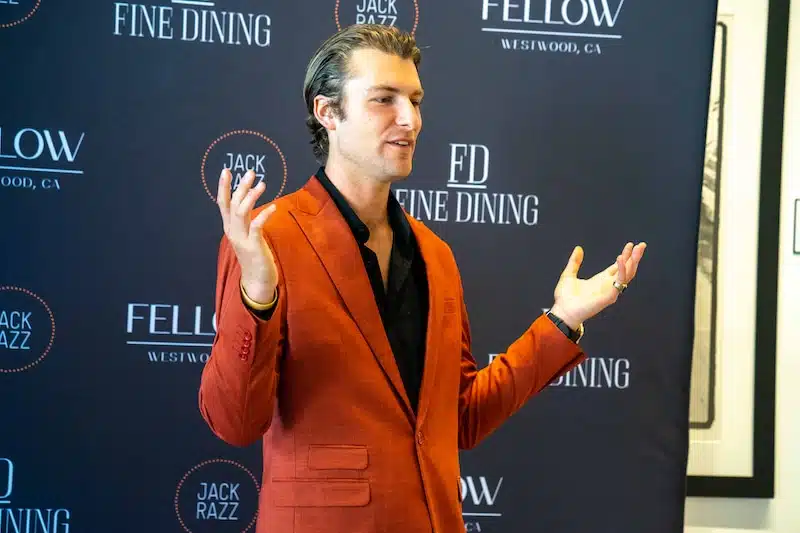
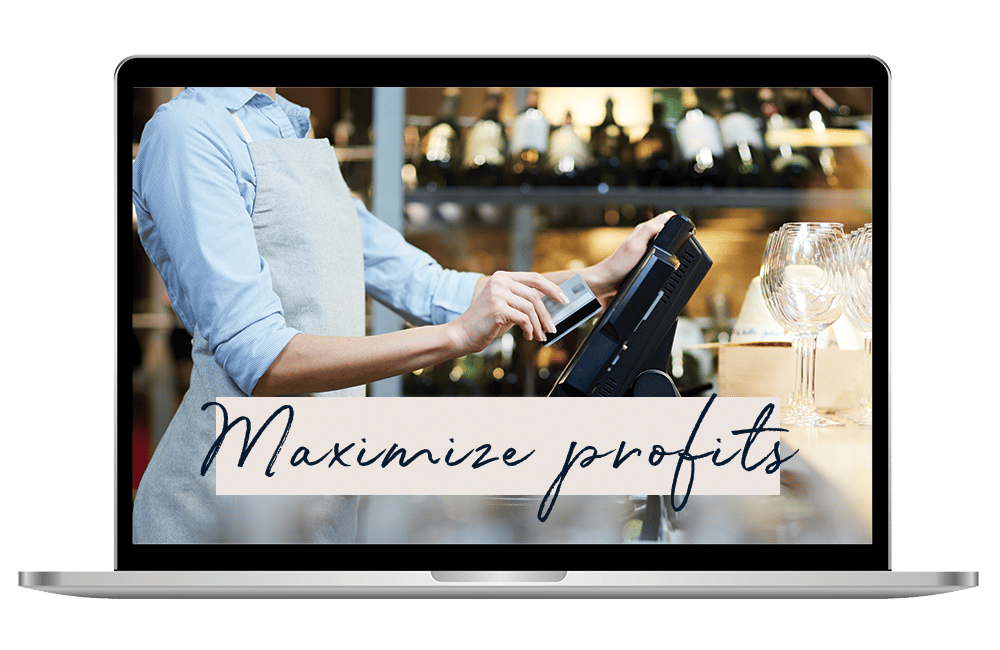
The three costly mistakes you could unknowingly be making?
Find out in this FREE guide and restaurant assessment specifically designed to reveal the unexpected hurdles standing between you and exponential business growth.
Thank You To Our Sponsors
Did You Know That 7 out of 10 Adults Dine Out To Celebrate Birthdays?
You Can Easily Capture This Lucrative Business!

The Employee Retention Tax Credit
We will help you determine your eligibility for 2020 & 2021 - Get Started
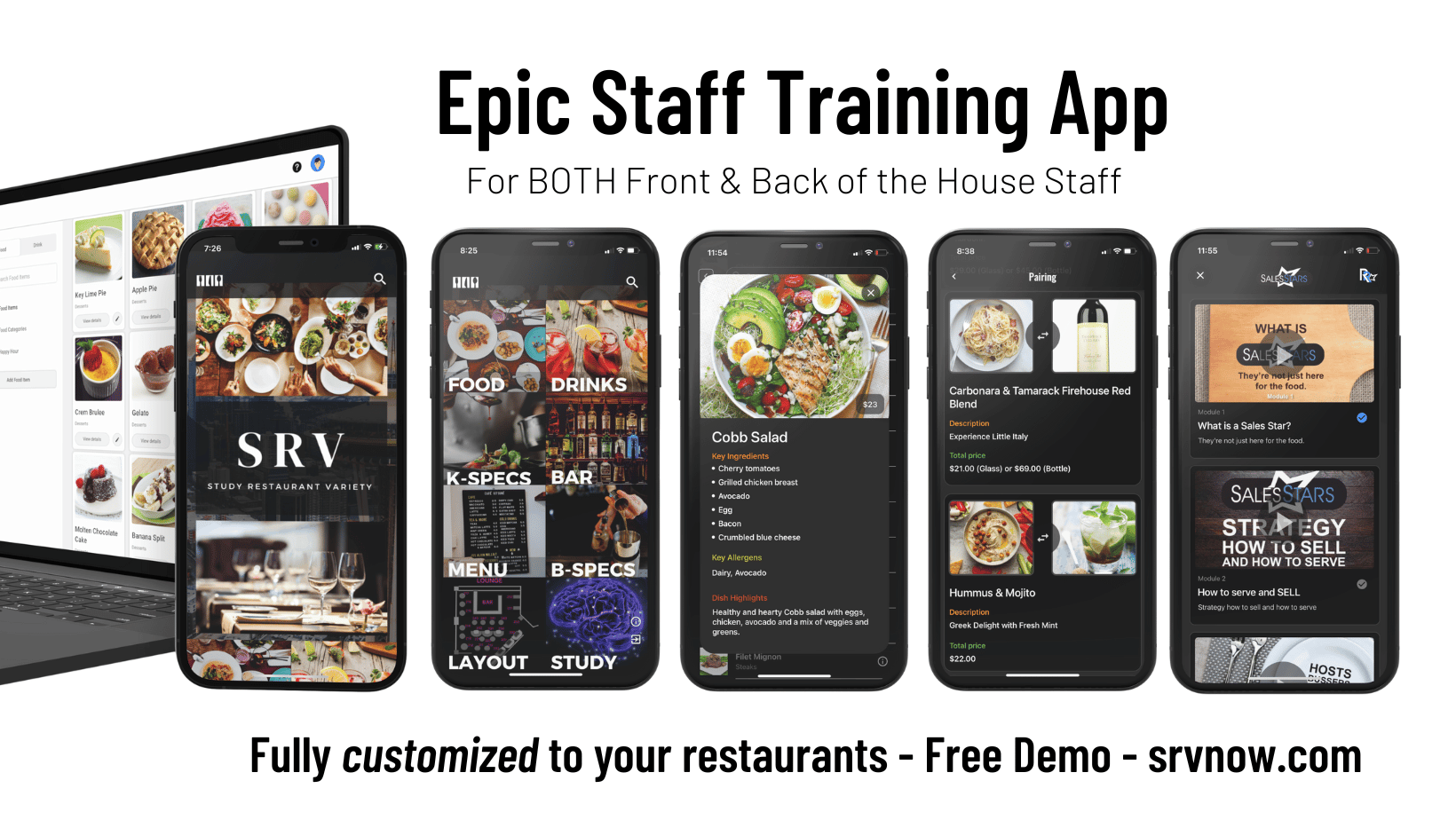
SRV teaches your team to profitably sell and accurately create the food and drinks at your restaurant.
Unlock Staff Potential and Maximize Sales
Want to become a podcast sponsor?
Please get in touch with Roger at roger@restaurantrockstars.com

